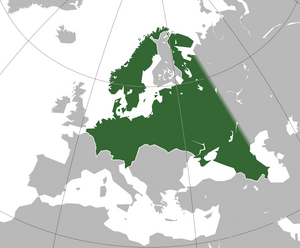
Back الرايخ الجرماني الأكبر Arabic Großgermanisches Reich Breton ڕایشی گەورەی جێرمەنی CKB Velkogermánská říše Czech Μείζον Γερμανικό Ράιχ Greek Gran Reich Alemán Spanish Grand Reich germanique French Reich Jerman Raya ID Grossgermanisches Reich Italian 大ゲルマン帝国 Japanese

The Greater Germanic Reich (German: Großgermanisches Reich), fully styled the Greater Germanic Reich of the German Nation (German: Großgermanisches Reich deutscher Nation),[2] was the official state name of the political entity that Nazi Germany tried to establish in Europe during World War II.[3] The territorial claims for the Greater Germanic Reich fluctuated over time. As early as the autumn of 1933, Adolf Hitler envisioned annexing such territories as Bohemia, western Poland and Austria to Germany and the formation of satellite or puppet states without independent economies or policies of their own.[4]
This pan-Germanic Empire was expected to assimilate practically all of Germanic Europe into an enormously expanded Reich. Territorially speaking, this encompassed the already-enlarged German Reich itself (consisting of pre-1938 Germany proper, Austria, Bohemia, Moravia, Czech Silesia, Alsace-Lorraine, Eupen-Malmedy, Memel, Lower Styria, Upper Carniola, Southern Carinthia, Danzig, and Poland), the Netherlands, the Flemish part of Belgium, Luxembourg, Denmark, Norway, Sweden, Iceland, Liechtenstein, and at least the German-speaking parts of Switzerland.[5]
The most notable Germanic-speaking exception would have been the United Kingdom: the Nazis' New Order envisaged the role of Britain not as a German province but instead as a German-allied seafaring partner.[6] Another exception was the German-populated territory in South Tyrol, an area which Germany assigned to its fellow-Axis power, Fascist Italy, in 1939. Aside from Germanic Europe, the Reich's western frontiers with France were to revert to those of the earlier Holy Roman Empire, which would have meant the complete German annexation of all of Wallonia, French Switzerland and large areas of northern and eastern France.[7] Additionally, the policy of Lebensraum required mass expansion of Germany and the settlement of Germans eastwards as far as the Ural Mountains (seizing territory from Lithuania, Latvia, Estonia, and the Soviet Union in the process).[8][9] Hitler originally planned for the deportation of any "surplus" Russian population living west of the Urals to resettlement east of the Urals in Siberia.[10]
- ^ "Utopia: The 'Greater Germanic Reich of the German Nation'". München – Berlin: Institut für Zeitgeschichte. 1999. Archived from the original on 21 May 2021.
- ^ Cowie, Stuart (ndg) "To what extent was the outbreak of World War Two, a consequence of failures in British Foreign Policy?" Academia.edu
- ^ Elvert 1999, p. 325.
- ^ Majer, Diemut (2003). "Non-Germans" under the Third Reich: the Nazi judicial and administrative system in Germany and occupied Eastern Europe with special regard to occupied Poland, 1939–1945. JHU Press. pp. 188–189. ISBN 0-8018-6493-3..
- ^ Rich 1974, pp. 401–402.
- ^ Strobl 2000, pp. 202–208.
- ^ Williams 2005, p. 209.
- ^ André Mineau. Operation Barbarossa: Ideology and Ethics Against Human Dignity. Rodopi, 2004. p. 36.
- ^ Rolf Dieter Müller, Gerd R. Ueberschär. Hitler's War in the East, 1941–1945: A Critical Assessment. Berghahn Books, 2009. p. 89.
- ^ Bradl Lightbody. The Second World War: Ambitions to Nemesis. London; New York: Routledge, 2004. p. 97.
© MMXXIII Rich X Search. We shall prevail. All rights reserved. Rich X Search